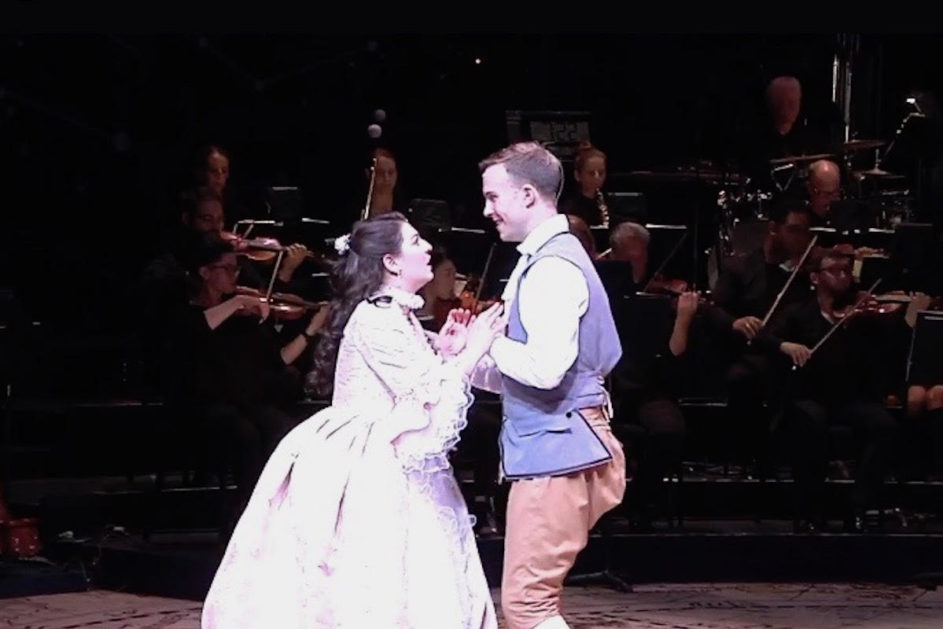There are as many unseen stars off-stage as there are in front of the lights in Clarence Brown Theatre/Knoxville Symphony Orchestra’s sumptuous production of Leonard Bernstein’s “Candide,” produced in celebration of the 100th anniversary of his birth.
The team of CBT lead director Calvin Maclean, co-director James Marvel, choreographer/co-director Casey Sams, set designer Michael Ganio and, especially, costume designer Bill Black created a dazzling visual and spatial feast for the eyes that equals KSO conductor Aram Demirjian and his musicians’ performance of Bernstein’s rich score.

Heidi Kettenring (center) plays the old lady in the Clarence Brown Theatre’s production of “Candide.”
With 14 named characters and a chorus of another 10 actor/singers carrying out a story that jumps around the world and back and forth in time, keeping up with it all is simplified by paying attention to Bernstein’s music and following Black’s beautifully articulated, character-describing costumes, along with listening to Voltaire, himself, as narrator and guide.
Following Voltaire’s view of the aristocracy, Black dresses Roderick Peebles’ Baron and Tracey Copeland Halter’s Baroness Thunder-ten-tronckh in regal attire, but black instead of silver and gold. In contrast, to highlight her purity and innocence, Black clothes their daughter, princess Cunégonde, beautifully sung and played by Cecilia Iole, in white and lovely pastels.
In a couple of details that highlight the centrality of the music’s role in telling the story, Ganio’s circular stage, painted as an 18th century map of the world, has a central, raised pedestal for Demirjian from which the directing team involves Demirjian as supporting character and prompter, mouthing many of the words.
In dual roles, David Kortemeier is both Voltaire, the story’s guide, and Pangloss, the court’s tutor. As Pangloss, he teaches his students, Candide (James Onstad) a commoner who loves princess Cunégonde and her brother Maximilian (Jonathan Christopher) the philosophy of Optimism, the idea that the best of all possible worlds currently exists (not the least of which means the preservation of the aristocratic system and separation of classes.) As Voltaire, he sets about showing Candide that life is far from ideal. It involves many pitfalls.
The Barony gets overthrown. Cunégonde is captured and becomes a sex slave, not only passed around, but also sent around the world in patchworked scenes of both time and place. Candide relentlessly goes to find her.
There isn’t a weak performance in the show. Onstad is quite good as Candide. Iole is exceptional as Cunégonde. She is a delight to watch and hear.
But it is the performance of Heidi Kettenring, singing the secondary role of Old Lady, a servant and Cunégonde’s maid, who comes close to stealing the show.
Writer Lillian Hellman first proposed to Bernstein, in 1955, the creation of a satire intended as a comic allegory of the activities Joseph McCarthy’s House Un-American Activities Committee, with which Hellman had run afoul.
The first production was a failure. Lots of rewrites, revisions and tinkering over more than 30 years, including ditching Hellman’s contributions, finally got the piece into a shape to survive. Had it not been for Bernstein’s music, much of which was a hit from the very beginning, it might not have. This production of based on the Scottish Opera’s 1989 version.
But still, putting together a production of “Candide” that is less chaotic than the story itself isn’t an easy task.
That’s why this one is such a resounding success.
“Candide” runs through Sept. 16. Tickets may be purchased at https://clarencebrowntheatre.com/ or by calling the box office at 865-770-4761.

